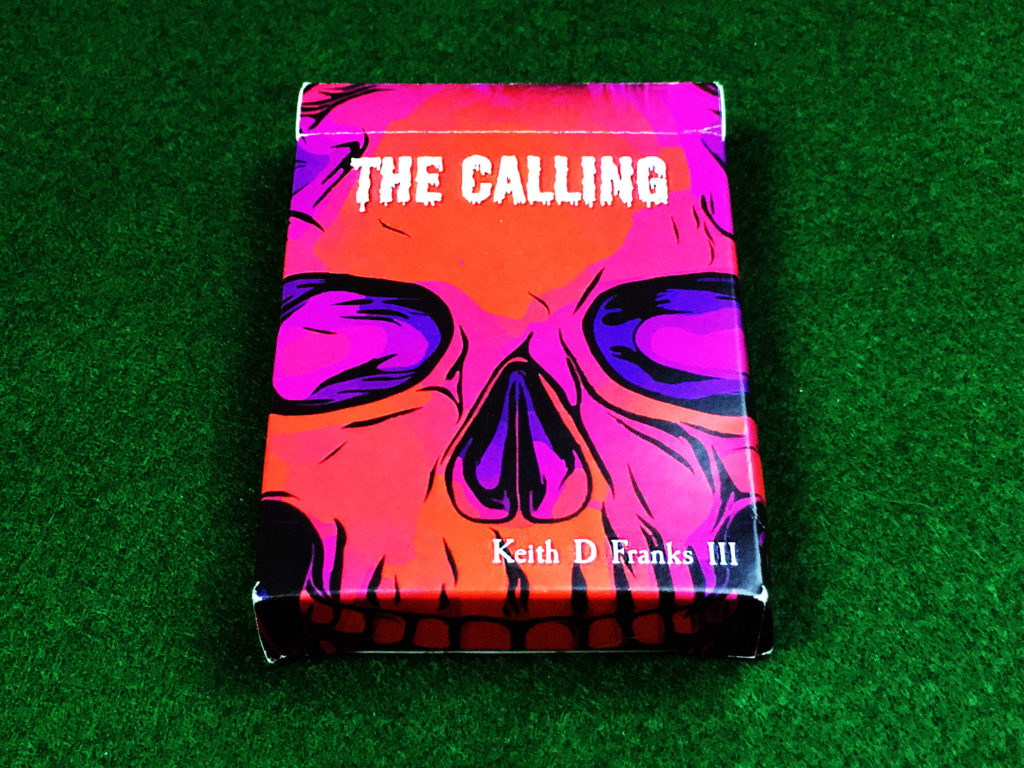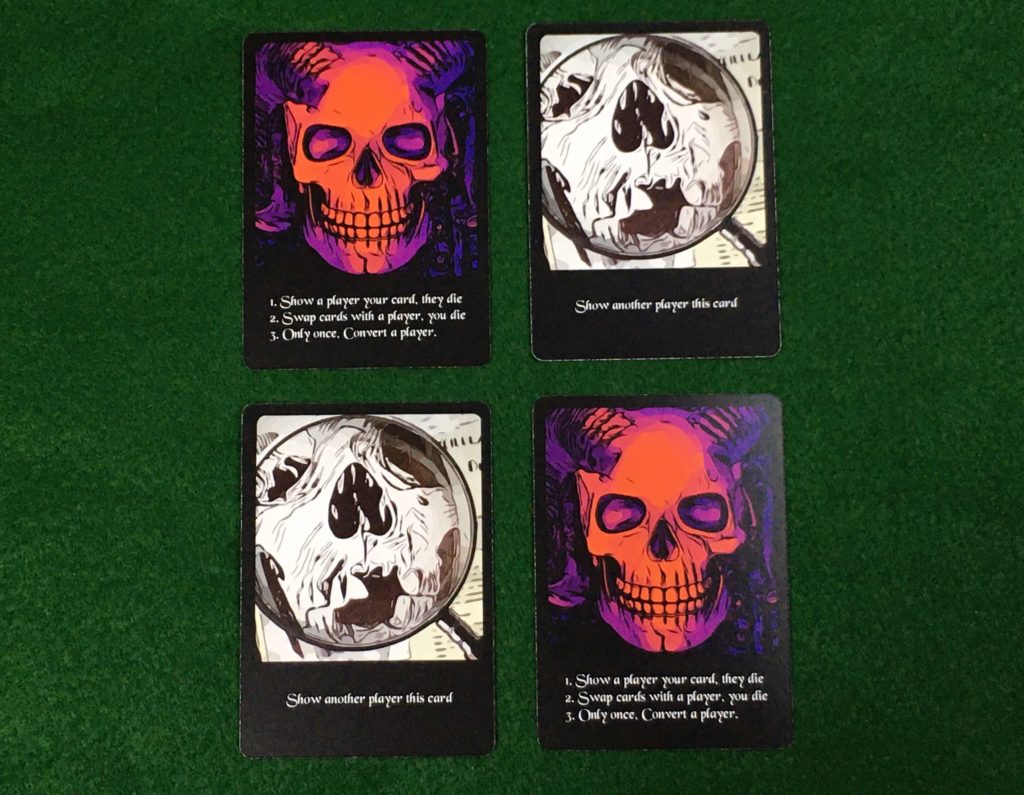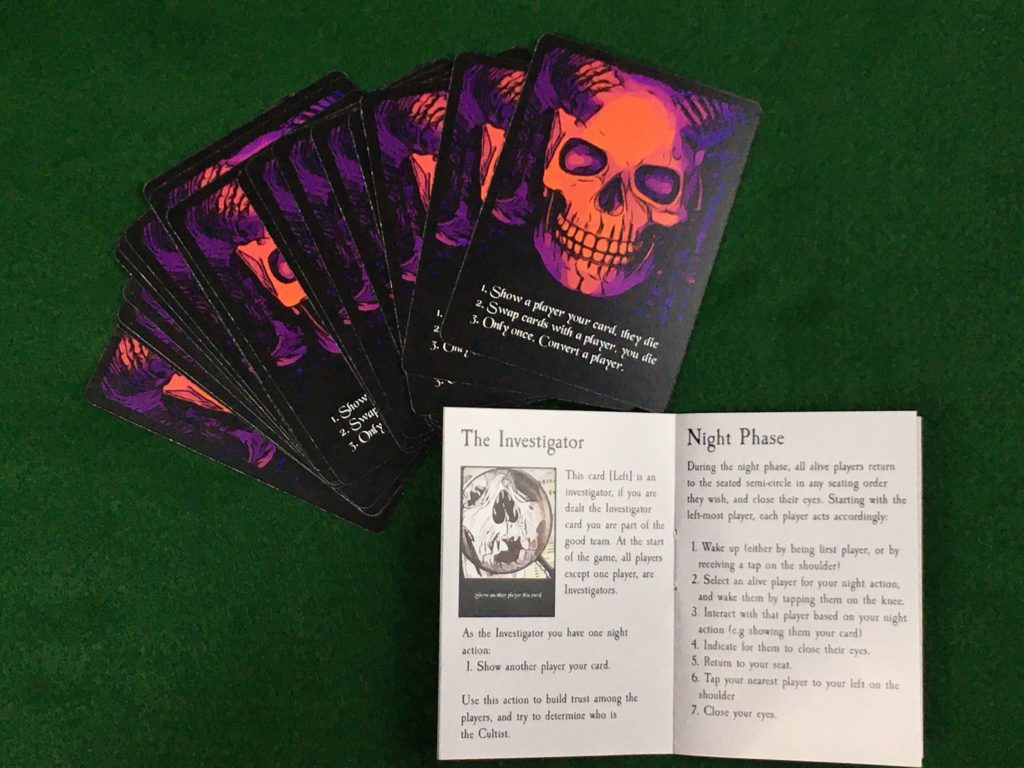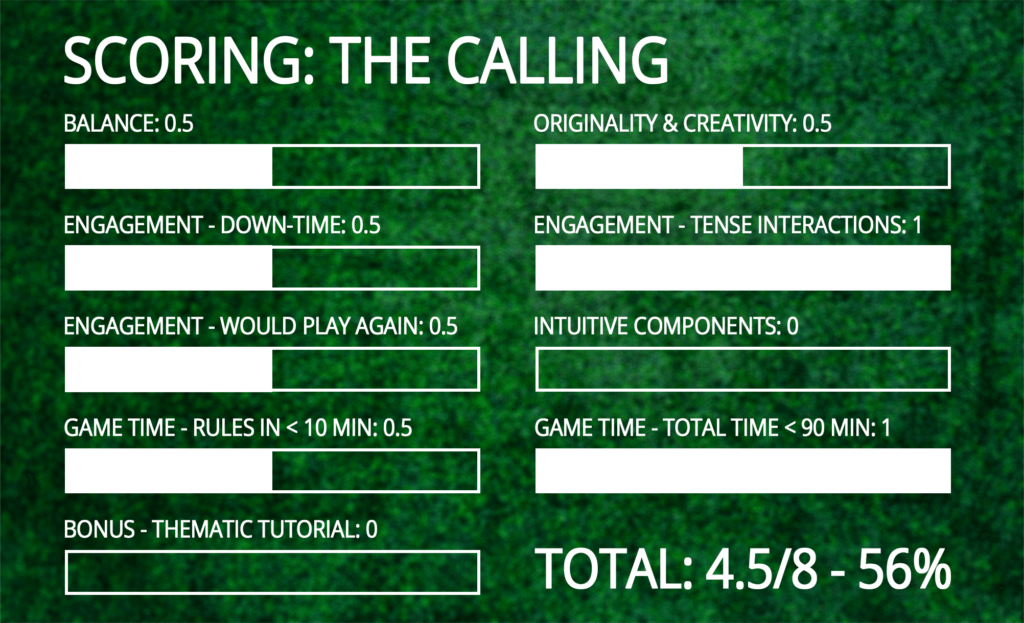
The Calling is a social deduction game by Keith D Franks III in which a large group of players starts off with one Cultist among the majority of Investigators. The Cultist can quickly gain footing by spreading their madness among the ranks of the Investigators.
Like the classic social deduction game Werewolf, this game has a Night Phase with players taking hidden actions while the group’s eyes are closed and a Day Phase with open discussion on who to vote out. Unlike Werewolf, it runs without a moderator, and the players who are voted out remain as active participants in the “Growing Army of the Dead.”
This is one in a series of seven articles outlining my judging decisions for the finalists in The Game Crafter‘s social deduction game design challenge. You can see the full article list here.
Visit Gamified Content’s YouTube channel to watch my review of The Calling’s shop page from the semi-finalist judging round.
High-Level Review
I love the concept of a large-group social deduction game that has the interesting interactions from Werewolf but removes the issue of player elimination and the need for a moderator.
Unfortunately, the lack of a moderator created confusion in our group that ended the game by the end of the first round three times in a row. This meant that we were never able to get a good chance to evaluate the way the eliminated players interacted with the active players.
I think this game has a lot of potential to become a well-loved iteration of Werewolf, but it will need more development and may be better implemented with a moderator to ensure a fun and smooth experience for all players.
Components
This game comes in a 36 card poker tuck box. Tuck boxes (along with their hook box cousins) are the most affordable packaging you can get from TGC. This is nice for keeping you game price down, but the drawback is that they can easily bend and wear out if you don’t fill them all the way up with the number of cards they are designed to hold. Adding 11 cards to this box (36-21-4 for the 16-page rule book) could help keep things more sturdy.
The front of the box has a clean design with the game’s logo title (which uses a nicely thematic, cool looking font), a full-bleed image the wraps around the sides of the box, and the designer’s credit.

The back of the box is totally blank, which I think is a missed opportunity. At the very least, I would like to see the player count, age range, and play time along with a brief description of the setting and basic mechanics I should expect to find inside.

The components for this game are extremely simple. There is only one type of card, and every card is identical. Each is 2-sided with the Cultist identity and action instructions on one side and the Investigator identity and action instructions on the other.
As a general rule, I like it when a game has the simplest components possible. Fewer components often mean the game will be more affordable. Plus, simple components can reduce setup time as well as the time needed to keep things organized throughout the game.
Unfortunately, it’s also possible for game components to be so simple and minimalist that they don’t support players in everything they’ll need to do during the game. This was the case for the components in The Calling.

The rule book says it’s recommended to get one lanyard and name tag holder for every player. This, of course, is breaking the rule of thumb to include everything needed for your game in the game’s box. In this case, it’s borderline forgivable because this game feels like it was designed specifically to replace late night Werewolf sessions at game conventions — where players would already have a lanyard.
From the rule book’s setup section:
Take cards from the deck … equal to the number of players, ensuring that only one Cultist card is facing forward, then each player is dealt a card at random. This card becomes their character, and is kept secret, facing inwards on their lanyard.
Even reading this and picturing going through the setup, you can likely see an issue with keeping all players’ identities secret. Unless you do more than what is explicitly stated here, everyone will see who everyone else is because the back of the card will automatically be different for the Cultist player.
Since I know the intention of this setup is to get one secret Cultist among the group, I tried to make a slight correction to these instructions to at least get to the point where we could try playing. I happened to have access to lanyards at the venue where I played this, so I attempted to follow the recommendation to use them. I had planned to also put a blank piece of paper in every lanyard and slide the cards into the lanyards under the paper with the identity they represented facing down towards the table, then mix them around and pass them out face down.
I recognized that this process would be a bit work-intensive, but it was the best way I could think of to keep the card back hidden. The work involved wasn’t the only drawback to this setup plan, though.
First, even with access to lanyards, there are many different kinds of lanyards and badges. Some convention badges are printed directly on plastic with no transparent sleeve. Many lanyards have a metal piece attached to the badge that allows it to easily spin and show the back. Still others are made of cloth with an opaque back and transparent window in front.
Taking all of this into consideration, I made sure to gather badges with each end of the lanyard attached to opposite upper corners of a fully transparent badge sleeve. Unfortunately, this badge configuration still managed to get twisted and immediately revealed the Cultist before we even started our first play, forcing us to re-set the game. It was frustrating for all involved.
After this, we decided not to use lanyards at all and leave it to each player to remember which identity they currently had. Each player continued holding their cards for reference and to use in their night interactions, but we all agreed that the facing and placement of the cards would be irrelevant.
We also got a pack of numbered cards to use for assigning the roles. We told everyone that if they got the 66 card, they were the starting Cultist.
Both our stand-in system for handling the cards and the instructions from the rule book felt fragile to me. The fact that you always have the exact same card no matter your role was the root of this problem. It creates lots of opportunities for people to break the rules by switching sides when they aren’t supposed to:
- switching at an opportune time based on what they think would put them on the winning side
- playing as an agent of chaos just to mess with people
- getting confused about what does or doesn’t constitute switching roles
- straight up forgetting their role (maybe not likely, but definitely possible if they have trouble with their short-term memory or play too many games in a row)
My suggestion for addressing all the issues our group had with the cards is to create separate sets of cards for the Cultist and Investigator roles.
Make the backs of all of these cards the same. Since the rules are so simple, the backs could even be the player aid that lists a quick reference of all the rules for every role (Cultist, Investigator, and Dead).
If the cards were set up this way, you could form a deck of Investigator cards one less than the total number of players plus one Cultist card, shuffle them, and hand them out face down. When a Cultist turns an Investigator into another Cultist, they could take the player’s Investigator card and exchange it for a Cultist card from a single face-down stack of cards in the middle of the group (either on the floor or maybe on the seat of an empty chair.
If the max player count were adjusted to 17 players, there could be 16 Cultist and 16 Investigator cards. This uses more of the 2 sheets of 18 poker cards already needed for a 21 card deck, keeping the price exactly the same. It would also perfectly fill the 36 card tuck box the game uses, helping keep it more sturdy as mentioned above. Also, since the game has such simple and affordable components, it would be easy for customers to expand the max player count to 33 if they buy a second pack.
You could tell players to store cards in their lanyards to keep them from bending or storing them in a sweaty back pocket, but they wouldn’t be so necessary that you’d need to include them as a recommendation in the components list.
One other issue with the design of these cards is that black borders show wear very easily which can create noticeable marks on the backs of the cards. This can negatively affect game play for a social deduction game where everything hinges on players’ identities staying hidden. Pure white borders have a similar problem of easily getting grimy from the dirt and oil on players’ hands. Notice that casino grade playing cards have full-bleed patterned backs. This is the approach I’d recommend for any social deduction card back’s border.

I thought the rule book that fit into the compact card box was nice. In general, I liked that this game was compact and listed for sale at a very reasonable price on its TGC shop page.

There were only two pieces of art in the entire game, but both of them were striking and used to good effect.
Game Play and Mechanics
One action the Cultist can choose is to convert an Investigator to a Cultist. Each Cultist can only do this one time per game. This ability created confusion and, combined with the semi-circle seating arrangement allowed for a slam-dunk strategy for the Cultist team.
The confusion was created when the Cultist was trying to kill an Investigator but the Investigator got the impression they were being converted. When players were asked to go to the Growing Army of the Dead if they were killed, no one got up, and players couldn’t discuss what had gone wrong without revealing their identity. The opposite could also easily happen, but both would be less likely if the role cards were separated into two types as suggested above.
The slam-dunk strategy for the Cultists the players in our group identified was for the Cultist to make sure to sit in the left-most position of the semi-circle the first round, then immediately convert the player to their right to a Cultist. That converted player would then know to convert the player to their right and so on. By the end of the first round, everyone would be a Cultist and everyone would win.
A couple of possible solutions for this exploit our group thought of were to change the rule to only allow one new Cultist conversion per night (and add a moderator to police this) or to have everyone sit in a circle and randomize both the seating arrangement and the starting point each round.
You could randomize the starting position in the circle by flipping a card with an arrow on both sides into the center of the seated players. Whoever the arrow points to will start the Night Phase, and the person to their left will be the last to act.
Another concern my group of testers brought up was that the players walking around and interacting in the circle could make noises and create a tell. Instructing all players to stomp their feet the entire time they are seated during the night could help this.
Scoring
The following scoring breakdown is based on a rubric I released during the game design challenge on TGC’s contest page. All sections are worth a maximum of 1 point.

Balance: 0.5
As explained above, our group identified an exploit for the Cultists’ side which players felt was an unfair disadvantage to the Investigators. In practice, though, we seemed to have come to an unspoken agreement not to use that exploit, and the Cultist side never managed to win.
Originality & Creativity: 0.5
This game is strikingly similar to Werewolf and uses a Cthulhu theme that is very common in tabletop games, so it doesn’t seem fair to call it truly “original.” However, it does include some new and interesting ideas for mechanics, so I felt it should get partial credit here.
Engagement – Down-Time: 0.5
Since everyone gets a turn in the Night Phase, this portion can add up to a lot of time with everyone waiting with their eyes closed while others take their turns. This would be even worse with a full group of 21 players than it was with our group of 8.
Engagement – Tense Interactions: 1
The Day Phase had plenty of that classic social deduction feel of “trust no one.” The Cultists’ ability to create more Cultists made for an interesting dynamic of the group not even knowing how many people among the other members were untrustworthy.
Engagement – Would Play Again: 0.5
Although I would not play the game as written again, I would be interested to play a future iteration. I feel that I personally would enjoy this game more if there were a moderator to help players move through confusing patches and keep the game running.
Intuitive Components: 0
The double-sided cards caused our group a lot of confusion and frustration. The fact that we needed to pull out another game with numbered cards to even get the game set up was a major drawback.
Game Time – Rules in under 10 min: 0.5
Though the rules of this game are ultimately pretty simple, it was not at all easy or efficient for me to teach. The fragile setup of the double-sided cards, the lack of a moderator, and the confusion around what it means to be the Cultist vs a member of the Cultist team in the Growing Army of the Dead all combined to create confusion and chaos while I tried to explain how to play.
The group I played with were serious tabletop gamers who were familiar with Werewolf and other social deduction games. Unfortunately, I think this familiarity mixed with their knowledge that The Calling was not traditionally published and up for judging in a game design contest contributed to their unruly behavior during the teach. They talked among themselves over me as well as interrupting me multiple times with assumptions, questions about things I hadn’t gotten to the point of explaining yet, and criticisms of the problems a lack of moderator was likely to create (before even trying to play it as taught). This made the teach stressful and irritating for me, which got the entire experience with this group off to a bad start.
You could argue that this is not the game’s fault. It’s possible that a different group and/or a quieter setting would have made the rules teach go more smoothly. However, any time a large group needs to learn how to play a new game together, there is a high likelihood there will be at least one disruptive participant that can’t stay quiet or pay attention. And, once one person starts causing a disruption, in my experience, it’s common for others to follow.
Providing a script that the person teaching can read to the group may help reduce the burden on the teacher.
Game Time – Total Time under 90 min: 1
Our games all ended after only one round either because someone got confused and needed to reveal the Cultist to get their question answered or because we easily picked out the Cultist and killed them before round 2.
It’s unclear to me how long this game would take if played with a full 21 player compliment who all understood the rules and strategy such that they were able to play through round 3. It’s possible that situation could take longer, but, since our group of 8 was able to play multiple times within 90 minutes, I’ve given full credit on this point.
Bonus – Thematic Tutorial: 0
The theme of this game was great, but there was no tutorial mode that used theme or story to help walk players through the process of learning how to play.
Total Score: 4.5/8 – 56%
You can see the scoring breakdown for all the semi-finalists and finalists in this game design challenge in my public scoring spreadsheet.
Credits
Thank You to Greeley Game Night
For providing the space and access to the large group of gamers I need to play test this game.
Leave a Reply